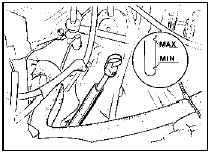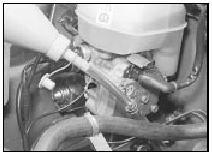Automatic transmission fluid level check (Every 12 000 miles (20 000 km) or 12 months)
1 Fluid level should be checked with the transmission at operating temperature (after a run) and with the vehicle parked on level ground.
2 Open and prop the bonnet. With the engine idling and the handbrake and footbrake applied, move the gear selector through all positions three times, finishing up in position “P”, 3 Wait one minute. With the engine still idling, withdraw the transmission dipstick (see illustration).

17.3 Automatic transmission dipstick location and markings
Wipe the dipstick with a clean lint-free rag, re-insert it fully and withdraw it again. Read the fluid level at the end of the dipstick: it should be between the two notches.
4 If topping-up is necessary, do so via the dipstick tube, using clean transmission fluid of the specified type (see illustration). Do not overfill.

17.4 Topping-up the transmission fluid
5 Stop the engine, refit the dipstick and close the bonnet.
6 Note that if the fluid level was below the minimum mark when checked or is in constant need of topping-up, check around the transmission for any signs of excessive fluid leaks.If present, leaks must be rectified without delay.
7 If the colour of the fluid is dark brown or black this denotes the sign of a worn brake band or transmission clutches, in which case have your Ford dealer check the transmission at the earliest opportunity.
See also:
Rear wheel cylinder (drum brakes) - removal, overhaul and refitting
Caution: Refer to the
precautions in Section 1.
Saloon, Hatchback and Estate
models
1 Chock the front wheels, loosen the relevant
roadwheel nuts, then jack up the rear of the
vehicle and support ...
Engine/manual gearbox assembly - reconnection and refitting
1 Reverse the procedure described in Section
11, noting the following points.
2 Before attempting to reconnect the engine
to the gearbox, check that the clutch friction
disc is centralised. This i ...
Throttle cable - adjustment, removal and refitting
Adjustment
1 Disconnect the battery earth lead.
2 On manual transmission models remove
the air cleaner unit, as given in Section 2.
3 Get an assistant to sit in the driving seat
and fully depress ...
